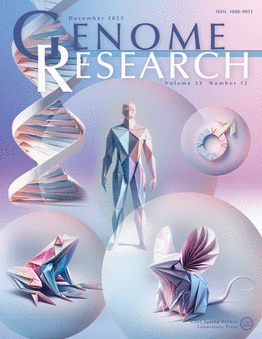Measuring X inactivation skew for X-linked diseases with adaptive nanopore sequencing
IF 6.2
2区 生物学
Q1 BIOCHEMISTRY & MOLECULAR BIOLOGY
引用次数: 0
Abstract
X-linked genetic disorders typically affect females less severely than males due to the presence of a second X Chromosome not carrying the deleterious variant. However, the phenotypic expression in females is highly variable, which may be explained by an allelic skew in X-Chromosome inactivation. Accurate measurement of X inactivation skew is crucial to understand and predict disease phenotype in carrier females, with prediction especially relevant for degenerative conditions. We propose a novel approach using nanopore sequencing to quantify skewed X inactivation accurately. By phasing sequence variants and methylation patterns, this single assay reveals the disease variant, X inactivation skew, its directionality, and is applicable to all patients and X-linked variants. Enrichment of X Chromosome reads through adaptive sampling enhances cost-efficiency. Our study includes a cohort of 16 X-linked variant carrier females affected by two X-linked inherited retinal diseases: choroideremia and RPGR-associated retinitis pigmentosa. As retinal DNA cannot be readily obtained, we instead determine the skew from peripheral samples (blood, saliva and buccal mucosa), and correlate it to phenotypic outcomes. This revealed a strong correlation between X inactivation skew and disease presentation, confirming the value in performing this assay and its potential as a way to prioritise patients for early intervention, such as gene therapy currently in clinical trials for these conditions. Our method of assessing skewed X inactivation is applicable to all long-read genomic datasets, providing insights into disease risk and severity and aiding in the development of individualised strategies for X-linked variant carrier females.利用自适应纳米孔测序技术测量 X 连锁疾病的 X 失活倾斜度
X 连锁遗传病对女性的影响通常不如男性严重,这是因为女性体内存在第二个不携带有害变异体的 X 染色体。然而,女性的表型表现却千差万别,这可能与 X 染色体失活的等位基因偏斜有关。精确测量 X 染色体失活偏斜对了解和预测携带者女性的疾病表型至关重要,尤其是对退行性疾病的预测。我们提出了一种利用纳米孔测序准确量化X失活偏斜的新方法。通过对序列变异和甲基化模式进行相位分析,这种单一检测方法可揭示疾病变异、X 失活偏斜及其方向性,并适用于所有患者和 X 连锁变异。通过自适应采样丰富 X 染色体读数可提高成本效益。我们的研究包括16名X连锁变异携带者女性,她们患有两种X连锁遗传性视网膜疾病:脉络膜血症和RPGR相关性色素性视网膜炎。由于无法轻易获得视网膜 DNA,我们转而从外周样本(血液、唾液和口腔粘膜)中确定偏斜度,并将其与表型结果相关联。结果表明,X 失活偏斜与疾病表现之间存在很强的相关性,这证实了进行这种检测的价值,以及它作为一种优先考虑对患者进行早期干预的方法的潜力,例如目前正在对这些疾病进行临床试验的基因疗法。我们的 X 失活偏斜评估方法适用于所有长读取基因组数据集,可帮助了解疾病风险和严重程度,并有助于为 X 连锁变异携带女性制定个体化策略。
本文章由计算机程序翻译,如有差异,请以英文原文为准。
求助全文
约1分钟内获得全文
求助全文
来源期刊

Genome research
生物-生化与分子生物学
CiteScore
12.40
自引率
1.40%
发文量
140
审稿时长
6 months
期刊介绍:
Launched in 1995, Genome Research is an international, continuously published, peer-reviewed journal that focuses on research that provides novel insights into the genome biology of all organisms, including advances in genomic medicine.
Among the topics considered by the journal are genome structure and function, comparative genomics, molecular evolution, genome-scale quantitative and population genetics, proteomics, epigenomics, and systems biology. The journal also features exciting gene discoveries and reports of cutting-edge computational biology and high-throughput methodologies.
New data in these areas are published as research papers, or methods and resource reports that provide novel information on technologies or tools that will be of interest to a broad readership. Complete data sets are presented electronically on the journal''s web site where appropriate. The journal also provides Reviews, Perspectives, and Insight/Outlook articles, which present commentary on the latest advances published both here and elsewhere, placing such progress in its broader biological context.
 求助内容:
求助内容: 应助结果提醒方式:
应助结果提醒方式:


